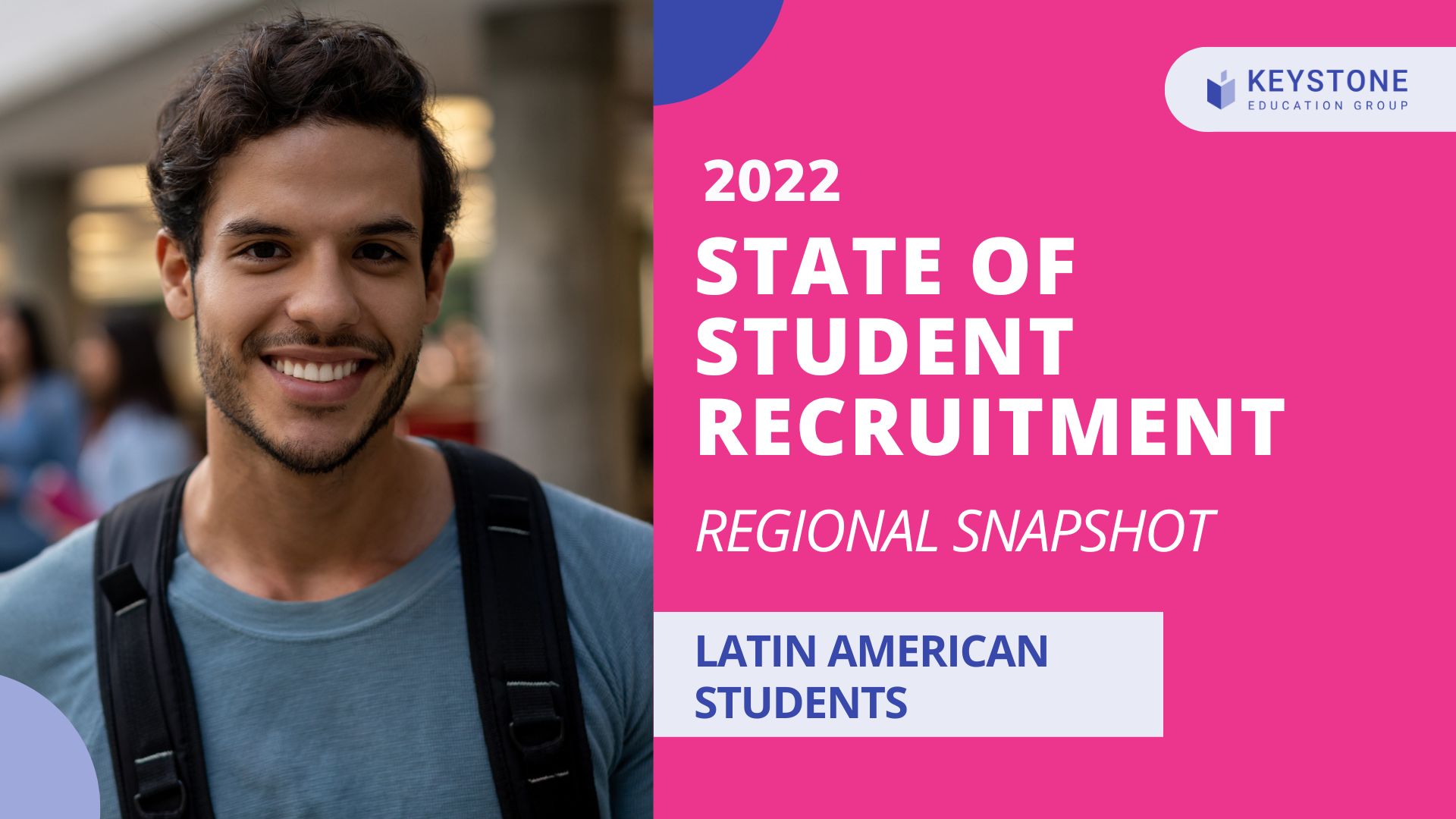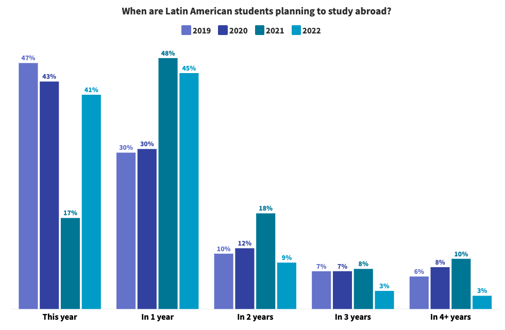
LATIN AMERICA
State of Student Recruitment 2022
Is Latin America a target market for your international student recruitment? Our findings will help update your understanding of how students from Latin America are thinking about study abroad and making decisions in 2022 and beyond.


Our Global Student Survey reached 1541 prospective students across Latin America and more than 20,000 students from around the world overall. View respondent data and customize country groupings with our State of Student Recruitment Dashboard to find out more about specific regions or countries.
Included countries and regions:
Caribbean: Aruba, Bahamas, Barbados, Cayman Islands, Cuba, Dominican Republic, Grenada, Haiti, Jamaica, Martinique, Puerto Rico, Saint Lucia, Saint Vincent and the Grenadines, Trinidad and Tobago, Virgin Islands
Central America: Belize, Costa Rica, El Salvador, Guatemala, Honduras, Nicaragua, Panamá
North America: Mexico
South America: Argentina, Bolivia, Brazil, Chile, Colombia, Ecuador, Falkland Islands (Islas Malvinas), Guyana, Paraguay, Peru, Suriname, Uruguay, Venezuela
Watch the State of Student Recruitment Latin America webinar
Report Highlights
- Latin America has the highest proportion of prospective undergraduate (63.6%) and PhD/Doctorate students (34.8%) who prefer Instagram to get more information about a university
- There are more students looking to study Languages at the undergraduate (17.6%) and postgraduate (13.1%) levels in Latin America than in any other region
- 135.4% more Latin American prospective students are planning to study abroad in the upcoming year, solidifying the global trend of shorter student journeys
- After an increase of 13.6% since last year, Latin America tops global proportions of students that find ranking lists as helpful in study abroad decision-making (34.1%)
- Mexico has the most students who identify the program as their first priority (71%) across global regions followed by South America (68.6%)
- 10.5% of Caribbean students and 10.1% of South American students prefer online classes to in-person or hybrid classes, contributing to a 234.9% increase in the year-on-year popularity of online classes overall
- Latin America has the highest proportion of prospective undergraduate (63.6%) and PhD/Doctorate students (34.8%) who prefer Instagram to get more information about a university
Study Abroad Trend Overview
Top Destinations: Australia and Portugal have risen as top study abroad countries by 181.7% and 365% respectively
The United States is the top destination for Latin American students for the fourth year in a row despite a 16.2% decrease in popularity this year. Interest in the United States is especially high for students from Central America (22.7%). Though other popular English-speaking destinations of Canada and the United Kingdom continue to place second and third this year in Latin America overall, a closer look shows that Mexican students ranked Canada as their top destination in 2022 (17.6%). An English-speaking country further down the list, Australia, has increased in popularity by 81.7% since last year.
Both Spain (10.7%) and Portugal (2.8%) are at their highest proportions of student interest in Latin America when compared to other world regions. Latin American student interest in Spain has increased by 56.5% overall, taking the fourth spot on this year’s list. Spain’s popularity in Latin America mostly stems from Central America (13.4%), South America (10.8%), and the Caribbean (13.2%), while only 3.5% of Mexican students indicated Spain as their top destination. Portugal shows an even more impressive change, with 365% growth since 2021.
Germany is another destination that sees more student interest this year after a 42% increase in popularity. Interest in Germany is especially pronounced in Central America (12.4%) and South America (9.6%).
Top Programs: There are more students looking to study Languages at the undergraduate (17.6%) and postgraduate (13.1%) levels in Latin America than in any other region
The top study subjects of interest for Latin American students differs from other world regions such as North America or Europe, where Health Care & Medicine rises high across all degree types. While this subject is by far the most sought-after for Latin American students looking to find PhD or Doctorate degrees, other subjects see more popularity for the undergraduate and postgraduate degree types.
Business & Administration in particular holds an impressive amount of attention in this region for students looking for undergraduate and postgraduate degrees, with the second-highest proportions of student interest globally. There are more Latin American students looking to study undergraduate degrees in Languages (17.6%) and Administration Studies (8.8%) than anywhere else, and Art & Design (15.3%) falls second only to Europe (17.7%).
Interest in studying Languages is also at its highest global level from postgraduate-interested Latin American students (13.1%). Students wanting to study this degree type also have high interest in Business & Administration (20.6%) and Engineering (13.9%) as subjects of study, both of which are the second-highest regional numbers globally.
Student Journey: 135.4% more Latin American prospective students are planning to study abroad in the upcoming year, solidifying the global trend of shorter student journeys
The student journey for Latin American prospective students is getting shorter than ever, mirroring a trend across all world regions this year. The proportion of students planning to study abroad ‘this year’ has skyrocketed by 135.4% since 2021, nearly reaching pre-pandemic levels.

Over three quarters of prospective Latin American students in this year’s survey also indicated that they began researching their study options less than six months before applying (75.2%). The turn towards shorter-term planning heightens the importance of efficient targeting and marketing post-pandemic.
Top Motivations: After an increase of 13.6% since last year, Latin America tops global proportions of students that find ranking lists as helpful in study abroad decision-making (34.1%)
When it comes motivations to study abroad, Latin American students seem to maintain the top three reasons to study abroad from previous years: ‘Achieve my career goals’ (46.8%), ‘Experience a new culture or lifestyle’ (46.2%), and ‘Develop myself personally’ (42.2%). As expected, the motivation of learning a new language is quite high (20.9%), the third-highest in the world after the UK and Ireland (23.7%) and North America (22%).
More significant changes surface when examining Latin American students’ most helpful resources in the decision-making process for study abroad. ‘Ranking lists of top schools, countries, and programs’ have become more important this year overall by 13.6%. When comparing within world regions, Central America can be found to have the highest global proportions of students who prioritize ranking lists (37.3%), scholarships and funding information (73.6%), study abroad fairs (15.5%) and study abroad guides (30.9%) when making decisions about study abroad.
Marketing Insights
Top Considerations: 10.5% of Caribbean students and 10.1% of South American students prefer online classes to in-person or hybrid classes, contributing to a 234.9% increase in the year-on-year popularity of online classes overall
To learn about how Latin American students make study abroad decisions, we asked what they consider first when deciding where to study abroad. Both the program and the country show continued trends across the last four years. The program continues to increase in importance for students from this region, jumping by 37.8% as a top consideration since 2019. This increase makes Latin America the global region with the most students who prioritize the program first (66.4%). Within global regions, Mexico has the most students who identify the program as their first priority (71%), followed by South America (68.6%).
In contrast, the study abroad country shows a trend of lowered importance. A decreasing proportion of Latin American students have prioritized the country every year, dropping by 45.7% since 2019. The most year-on-year variation comes from the school as a first consideration. Though the school has decreased in importance by 27% since 2020 overall, intra-regional data shows that 19.8% of Caribbean students and 19.1% of Central American students continue to favor the school while only 9% of Mexican students indicate the same.
The students who prioritize the program first show very similar program preferences as last year. The top three most important factors remain the same: ‘Program content and modules’ (63.5%), ‘Work placement and/or internship opportunities’ (59.4%), and ‘Quality of professors and teaching’ (49.8%), though it is worth noting that all three have decreased overall in importance. Factors that have become more significant to these students are ‘Study mode and flexibility’ (29.8%) and ‘Delivered online’ (8.2%), respectively increasing by 20.4% and a giant 330%.
The growing popularity of online classes is further solidified when asking Latin American students about their preferred class mode. This popularity however, is fragmented between regions, with 10.5% of Caribbean students and 10.1% of South American students contributing to a 234.9% increase in comparing last year’s numbers to this year in Latin America overall. South American students also show a higher preference for mixed or hybrid classes than other Latin American regions, and fall beneath the others when it comes to student preference for in-person classes.
Top Influences: Latin America has the highest proportion of prospective undergraduate (63.6%) and PhD/Doctorate students (34.8%) who prefer Instagram to get more information about a university
Where does your institution have a social media presence? The global impact of social media is clear, but study-level preferences can vary greatly. What do Latin American students’ behavior on social media platforms look like according to their study level of interest? According to this year’s data, instagram is the social media platform of choice for students interested in all study levels. Latin America has the highest proportion of prospective undergraduate (63.6%) and PhD/Doctorate students (34.8%) who prefer Instagram to get more information about a university.
Facebook is the second most popular platform for Latin American students searching for undergraduate and postgraduate level programs to find more information about a school. The popularity of LinkedIn is especially prominent among Latin American students looking for postgraduate and PhD/Doctorate programs abroad.
Student Voices
Common Challenges
To understand the student perspective in this region more deeply, we asked: What are some common challenges for you and other students from your country who want to study abroad? Each response indicates the student's nationality, age, and highest completed degree level underneath.
- "Too expensive and language requirements... I don't have an IELTS or TOEFL certificate."
- Brazilian; 26-35; Bachelor's degree
- "The cost of living and paying for school in a foreign country is too high for us. Most of the scholarships that exist in the university are catered for persons either from Asia, Europe and the USA."
- Guyanese; 36-45; Graduate degree or higher
- "Lack of employment options that comply with international or extra regional degrees"
- Trinidad and Tobago; 18-21; High school degree or equivalent
Encouraging Students
We also asked: What might encourage you to study abroad?
- “To see that in other country I can get better opportunities than in mine”
- Colombian; 18-21; High school degree or equivalent
- “Availability of distance learning programs”
- Chilean; 26-35; Associate's degree
- “If I can get a scholarship or even a flexible part time job to help alleviate monthly expenses then I could consider the possibility of studying abroad.”
- Guyanese; 36-45; Graduate degree or higher
Dive deeper into the data with live dashboards